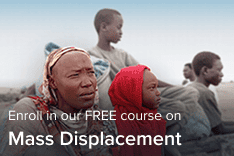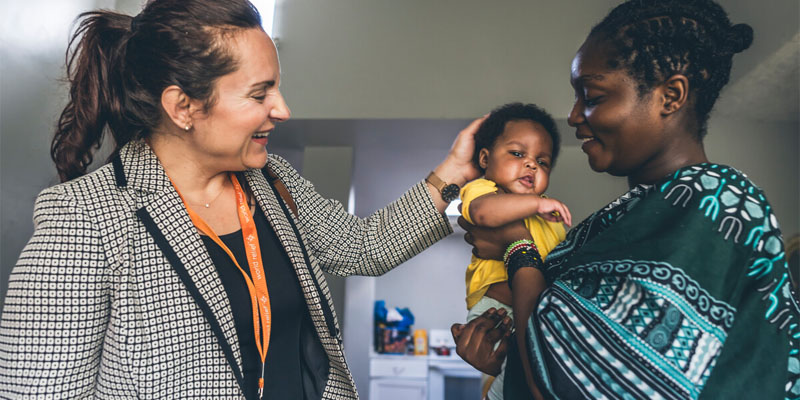Naomi’s Story
Naomi, her husband and three daughters were living in Mahowe, a small village in Malawi, when Naomi’s husband died. That day forever changed her life. Not only was her husband gone, but so too was her family’s source of income and daily security. Naomi and her daughters tried to rebuild their lives, but Naomi’s physical condition made things difficult. Partially blind in one eye, she struggled to earn enough money to send her oldest daughter to school, let alone meet basic needs for her and her daughters.
Sadly, Naomi’s story is not unique. In fact, more than 735 million people around the world — around 10% of the world’s population — live on less than $1.90 per day, making it difficult for them to earn a living, buy food, access health care or send their children to school. The consequences of such extreme poverty extend far beyond one generation, as uneducated children struggle to earn a living as adults, in turn making it difficult for them to send their children to school and ultimately trapping them in a vicious cycle of generational poverty.
Yet economic poverty isn’t the only kind of poverty that affects people around the world.
A Complex Problem
Hourt Rous is one of the 80% of Cambodians living in a rural area where women are taught that their sole role in life is to be a housewife and to raise children. Because of this belief, women like Hourt never have the opportunity to go to school or the chance to learn basic health practices and important lessons in child development. Hourt grew up in a home where she was taught health and nutrition were important only once children reached school age.
“I never knew nutritious food affected [a young] child’s development. In our culture, we are taught that our children’s physical appearance, health and food intake is [only] important when they reach school age.”
In Cambodia, much of rural childcare is based on cultural beliefs. Therefore, when Hourt became a mom, she began raising her children in the same way she had been raised, setting the stage for her children to do the same and continuing the cycle of poor health and education from generation to generation to generation.
These two stories have a great deal in common. Naomi, a physically disabled widow, was left as the sole caretaker for her girls, unable to provide basic needs for her family. Hourt, a female in rural Cambodia, wasn’t given the same access to education as the men in her community, which ultimately prohibited her from learning how to create a future for her children. Both these women were trapped in a multi-faceted cycle of poverty that is perpetuated by lack of access to education and healthcare and often determined by social status, age and gender, geography and ethnicity.
Complex but not Impossible
Solving poverty is complex. But complex does not mean impossible.
Understanding the full complexity of poverty is at the very core of our work at World Relief. In places most impacted by poverty, well-intentioned NGOs frequently struggle to create lasting change because they either fail to address the root causes of poverty — gender discrimination, conflict and inequitable access to education, to name a few — or fail to acknowledge that poverty is multifaceted.
Rarely is a community only struggling with physical poverty, economic poverty or geographical poverty. Rather, they are often struggling under the weight of more than one type of poverty. When organizations address poverty as a single issue and fail to acknowledge root causes, they create quick fixes and partial solutions that fail to produce holistic, long-term transformation.
But it doesn’t have to be this way. At World Relief, we believe God gave us a plan to save our broken world, and it begins with his church, and his people, leading the way.
As we engage in communities around the world, we harness and amplify the influence of the local church — the largest, most influential network on the planet — to model Jesus’ holistic method of addressing and alleviating poverty. By empowering pastors, local leaders and volunteers, the church moves as the hands and feet of Jesus. People are seen, loved and given opportunity for new life. Through him everything changes.
Jesus and Holistic Change
In Luke 4, Jesus begins his ministry by declaring,
“The Spirit of the Lord is on me, because he has anointed me to proclaim good news to the poor. He has sent me to proclaim freedom for the prisoners and recovery of sight for the blind, to set the oppressed free.”
Luke’s gospel is filled with stories of Jesus seeking out the poor in body, in community and in spirit. He heals a man of leprosy and a woman from her issues of blood, invites a tax collector into his inner circle and gives life to a widow’s dead son. He even heals a Jewish oppressor’s beloved servant.
To the leper and woman with the issue of blood, Jesus brought physical healing; to the tax collector, Jesus provided acceptance; to the dead son Jesus gave life; to the Jewish oppressor an example that no one is outside the love and care of God.
Jesus saw the tax collector, men, women and children, the sick, the oppressed, the lonely. He came toward them and provided for their needs, bringing restoration to the whole person, reversing life circumstances and breaking cycles. Over and over again, the gospel of Luke reveals Jesus’ love and care for the poor and the outcast, those marginalized by their economic status, gender and/or ethnicity.
Breaking Free and Moving Forward
Naomi began to break the cycle of generational poverty when she joined a savings group sponsored by World Relief. Through the group, Naomi has been able to invest in her family’s future. A year later she says,
“I now have the opportunity to interact with my friends and to improve my life. I have also joined my colleagues in helping the vulnerable in our community through the group’s social fund, a weekly fee which goes to the community’s needy individuals.”
In the same way, Hourt changed her family’s story when she joined a women’s group through her church and learned about children’s health. She began to implement what she was learning, providing the nutritional support her children need as well as promoting and protecting their access to education.
“I know that if I want my children to be wise and have a good future, I have to play a role in supporting the process of development,” Hourt says.
Not only has she improved her children’s health, but Hourt is also sharing what she’s learned with others.
“I take health lessons to teach households and improve everyone’s health in my community,” she says.
Although Naomi couldn’t see a future where her family had resources for food or education, her local church did. Although Hourt didn’t understand the importance of proper nutrition during early childhood, her church did. And, although both women felt unseen, unnoticed and forgotten, they weren’t.
Following Jesus’ examples, the church came as the hands and feet of Jesus with love, care and provision for Naomi and Hourt’s needs. The church came to lift them up and bring the restoration of Christ. It is in this restoration that Naomi, Hourt and thousands of others have been empowered to reverse their circumstances and break the cycles of poverty.
Now, they are one of the thousands around the world, coming with love, care and provision for others in need, breaking the cycle of poverty and propelling change that lasts.

Dana North serves as the Marketing Manager at World Relief. With a background in graphic design and advertising and experiences in community development and transformation, Dana seeks to use the power of words and action to help create a better world. Dana is especially passionate about seeking justice for women and girls around the world.


